
John Kean, The University of Melbourne
Seismic shifts occur infrequently on the cultural landscape, and the works produced at such rare moments accrue mystique over and above their individual artistic merit. The 220 early Papunya boards held at the Museum and Art Gallery of the Northern Territory are the most extensive collection of paintings from the critical juncture when contemporary Aboriginal art first emerged. When examined as a group they provide new insight into Australia’s most important atelier.
Early paintings by the first masters of desert art have a particular energy that comes from the moment of their creation. The meeting of men with differing life experiences, and originating from such a wide swathe of country, would not have occurred in the traditional context. The efflorescence of imagery that struck in the hothouse conditions of the Men’s Painting Room - a Nissen hut in the government settlement at Papunya in the Northern Territory - will not be repeated. For these works were created at the time when the epic songlines that connect Aboriginal Australia were first unveiled.
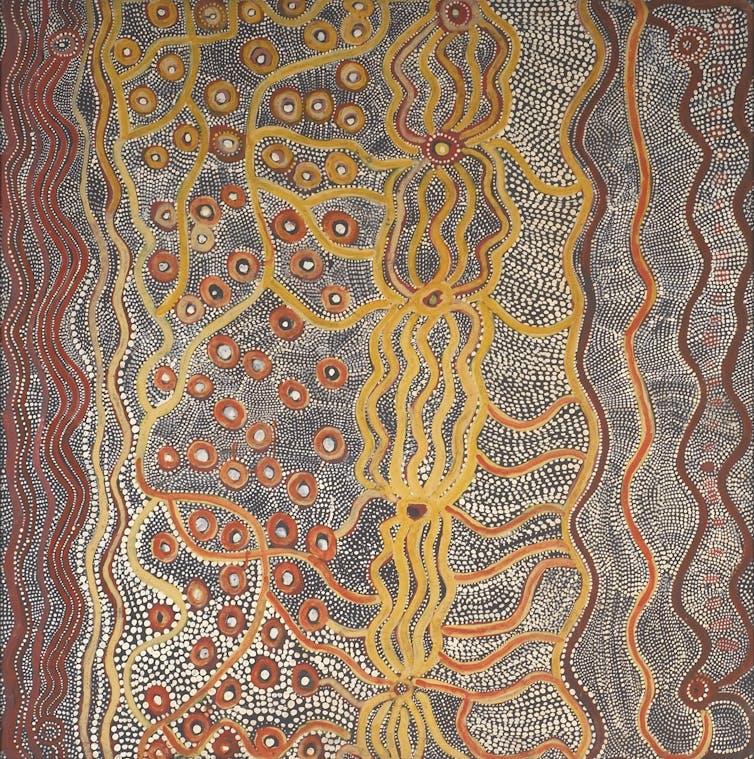
The gallery’s collection - highlights of which have been selected for the new exhibition Tjungunutja - reveals how the style and focus of Papunya painting developed, from the winter of 1971 until the end of 1972, as various approaches to the representation of country and ceremony were conceived, tested and modified.
The collection possesses many mysteries, not only of the restricted realm of men’s ritual but also the unfolding collaborative relationships that developed between these men who worked intensely to create a new form of creative expression.
Who were the Papunya Tula artists?
The 30 founding group painters are individuals over and above their linguistic affiliations or the commonalities of their historical experiences. It is therefore not my intention to constrain such individuals by easy classification, but merely to suggest commonalities that informed their approach to picture making. Nevertheless, I will delineate three distinct groups who painted in those heady days.

Anmatyerr
Anmatyerr men were critical to the formal development of painting at Papunya and Kaapa Tjampitjinpa was the movement’s first master. Kaapa was an Anmatyerr man with Ngaliya (Southern Warlpiri) associations who provided leadership to artists who came to Papunya from the cattle stations to the north and east of the settlement.
Frontier pastoralists had usurped Anmatyerr land in the early 20th century and as a consequence Kaapa and his cousins Billy Stockman Tjapaltjarri, Tim Leura Tjapaltjarri and Clifford Possum Tjapaltjarri had grown up as stockmen in an intercultural world.
While living as subjects in a paternalistic environment, these men understood that their labour and expertise were vital to the success of the cattle industry. They were familiar with topographical maps, paper and pencils as well as enjoying comics and other Western media. As accomplished carvers they were familiar with the market for “Aboriginal artefacts”.
Haasts Bluff Pintupi
The Pintupi speak a dialect of the Western Desert language. Johnny Warangula Tjupurrula, Mick Namarari Tjapaltjarri and Charlie Tjaruru Tjungurrayi were all boys when their families migrated in response to the devastating drought of the 1920s, settling with their extended families near Haasts Bluff (just 20 kilometres south of Papunya) in the early 1930s. The site was chosen for its proximity to a ration station established by Lutheran missionaries.
The Haast Bluff Pintupi lived in an intercultural context, alongside Anmatyerr, Kukatja, Luritja, Warlpiri and Western Arrernte people. Albert Namatjira and his relatives, the Hermannsburg landscape painters, were frequent visitors to the Haasts Bluff. Their “framing” of the landscape had a significant influence on the later development of Papunya Tula painting.
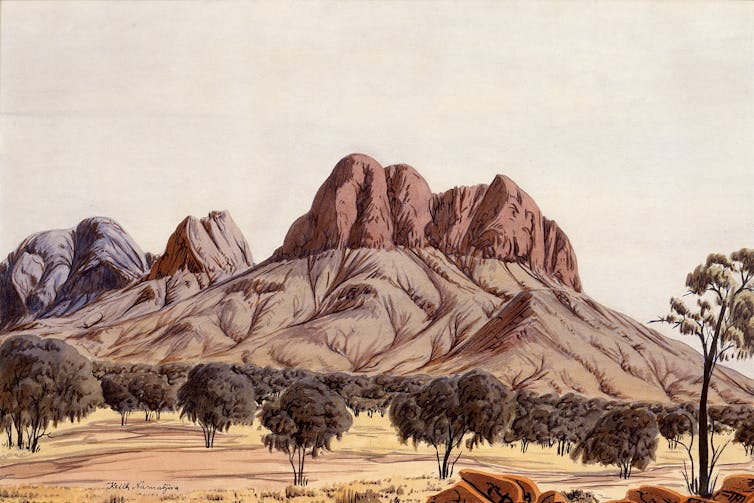
When it became apparent that the artesian water at Haasts Bluff would not be sufficient to supply the station’s swelling population, it was determined that a new settlement would be created at Papunya, where a generous bore had been struck in 1954.
Pintupi
The third group includes Shorty Lungkata Tjungurrayi and Uta Uta Tjangala, who were traditionally oriented Pintupi speakers. In contrast to the other groups, they were ritually mature men when they migrated east from the homelands to Haasts Bluff in the late 1940s and 1950s.
Other Pintupi families remained on their land with little or no contact with Europeans well into the 1960s. Eventually they too forsook their country and were transported, by truck, to the new government settlement. The Pintupi who had remained in their desert homelands were unfamiliar with Western media before they arrived at Papunya in the 1960s.
Kaapa’s alternative to drudgery
Namatjira and his sons demonstrated that artistic endeavour could provide an independent income to those with the confidence to negotiate a good price. By 1971, Leura and Possum had established reputations as carvers of hyper-real goannas and snakes, distinctively painted in the colours of life.
The fact that painting, like carving, offered an alternative to the drudgery of menial work around the settlement was not lost on Kaapa, who was determined to paint, with appropriated materials, on salvaged hardboard. It is no accident that Kaapa was observed in the company of Keith Namatjira (Albert’s son) “hawking” paintings around the community.
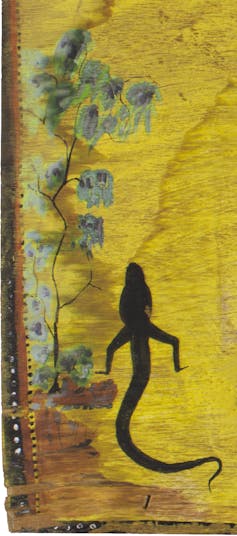
The Government Patrol Officer, Jack Cooke, also recalled seeing a curious “lemony-yellow” painting hanging on the wall of the Papunya “canteen”. Cooke described the work as “a bit of a mixture of styles: part Albert Namatjira gum trees, a goanna, and a bit of Aboriginal dot-style painting”. The work that was recalled so vividly by Cooke found its way into the gallery’s collection and is, I suggest, Kaapa’s first major painting and, therefore, the antecedent for “contemporary” desert art.
The remarkable efflorescence of contemporary art at Papunya did not emerge from barren ground. The link to the landscape painting tradition is deep rooted and enduring. Namatjira was also familiar with the major Honey Ant ritual centre at Papunya, which he used as a base while painting Ulunparru (Mt Edward) to its immediate south. Later, in 1959, Namatjira was placed under house arrest at the new government settlement, where he spent his last few months.
The geographical and temporal nexus between the Hermannsburg school and the Papunya school was marked by the publication of Rex Battabee’s Modern Aboriginal Paintings (1971), a coffee-table book celebrating the work of Namatjira and his followers. Seen in retrospect, the convergence of these events in 1971, signifies the transition from “modern art”, associated with the “assimilation policy”, to “contemporary art”, associated with the era of Aboriginal Land Rights and “self-determination”.
Having come to his attention at the Papunya canteen, Cooke entered several of Kaapa’s revolutionary new works in the Caltex Northern Territory Art Award. Recognition came swiftly when Kaapa Tjampitjinpa’s Men’s Ceremony for the Kangaroo Gulgardi (1971) was announced as joint-winner.
Not only did Kaapa receive the prize but all seven of the works Cooke had delivered to Alice Springs sold, returning around $750 to the artist. The news of Kaapa’s windfall caused a “sensation” back at Papunya.
Kaapa’s early paintings are profound statements of Indigenous ontology, and have come to be regarded as touchstones in the art-historical record. Moreover, his delicately painted boards speak eloquently of the social context in which they emerged. Painted with pilfered brushes on recycled materials, Kaapa’s early paintings materialised, with unprecedented clarity, out of a clash of cultures.
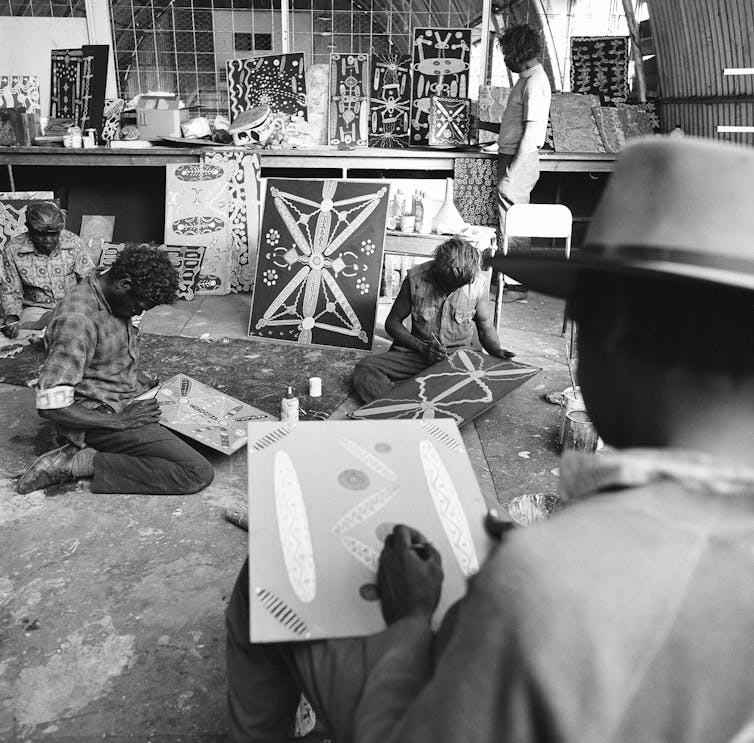
Papunya was regarded as the most “troubled” of the government settlements, and I contend that Kaapa saw the relationship between whites and Indigenous people at Papunya with singular clarity.
Still, Kaapa’s paintings were produced in a very different context to that which governs the circulation of Indigenous art in the new millennium. The fact that Ceremonial Scene (Mikantji) was displayed openly in the public space of a community store but is now regarded as containing “restricted” information draws attention to the social and cultural transformation that has occurred since the painting’s creation in 1971. To comprehend Kaapa’s original intention, we must strip away the assumptions that have accreted over the past 46 years.
Revealing men’s ritual
Ceremonial Scene (Mikantji) was produced in the last days of the assimilation policy, when local religion was suppressed in preference to an adherence to Christianity. It was assumed that Indigenous advancement depended on school attendance, training and compliance with regular working hours.
We must consider the possibility that Kaapa, who was a man of his times, shouldered some of the prevailing discourse that foreshadowed the demise of “classical” Indigenous culture.
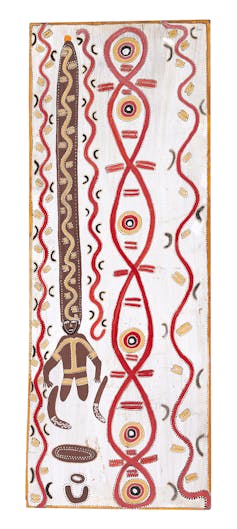
Such a proposition could mean that Kaapa painted his revelatory works to ensure the perpetuation of his dearly held ceremonies in a new form, fit for the environment that he anticipated. Notwithstanding his profound attachment to the “old ways”, Kaapa would have anticipated that his children received a better education and lived in a more empowered state than he had experienced - that, after all, being the trade-off in conforming to the onerous constraints of settlement life. (Though it can be argued that projected improvements have not eventuated and that despite decades of “self-determination” his children have not enjoyed the agency that Kaapa embodied.)
The majority of the large boards Kaapa painted in the spring of 1971 have been subsequently assessed to display restricted content, including tywerrenge/sacred objects. It is likely that, as well as providing a full account of totemic ceremonies, Kaapa was responding to the European desire to possess sacred objects at the heart of Indigenous religious belief.
The Finke River Mission at Hermannsburg was the hub of a worldwide trade in sacred objects throughout the 20th century. Lutheran preachers had fostered a market for “tjurunga” (tywerrenge) as a means of deriving income for the cash-strapped mission, and as a vehicle for replacing Indigenous religion with Christianity. The mercantile reach of the missionaries encompassed Napperby Station where Kaapa grew into manhood and Haasts Bluff where he worked as a stockman.
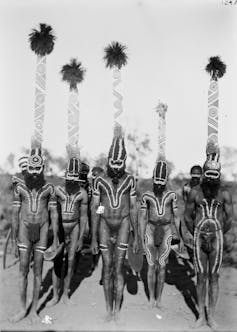
The trade in sacred objects persisted into the 1970s when it was still in evidence at Papunya and Alice Springs. Seen in this light, it is not surprising that the early paintings by Kaapa and his peers included graphic depictions of ritual objects.
Moreover, Kaapa, Stockman, Leura and Possum grew up at Napperby, where they learned that “Indigenous knowledge” could be traded. Possum’s foster father, Gwoya Tjungurrayi (aka One Pound Jimmy) had worked as a guide and informant with anthropologists T.G.H. Strehlow and C.P. Mountford.
Gwoya established a career as a “go-between” and in so doing, modelled the agency that could be derived by extracting value from his knowledge of country. Following in Gwoya’s footsteps, Kaapa cannily combined the demand for ethnographic material and his familiarity with anthropological interests to create a new product ideally suited for the coming age.
Kaapa was without doubt the most influential artist working at Papunya during 1971. His authority and expertise were also recognised by senior custodians who charged him with responsibility as “principal artist” for the Honey Ant Mural at the Papunya School.
The technical accomplishment and sophistication of Kaapa’s most ambitious paintings (in the NT gallery’s collection) can be testified to but not revealed, for they were assessed to transgress the boundaries of restricted men’s knowledge. Despite the necessary prohibition, the influence Kaapa had on his fellow painters must be considered, for his early paintings are masterworks that set the benchmark to which other artists aspired. Moreover, it can be argued, an echo of the precision with which Kaapa painted persists in the meticulous work by Papunya Tula artists to this day.
Figurative painting
The gallery’s collection contains many surprises, not the least of which is the number of paintings that employ figuration. We are are confronted by the visage of ancestral heroes, unencrypted by the dots, circles and signs for which the Papunya Tula art is best known.
While much Western Desert art requires extensive decoding, the form of the nine figures in Mick Namarari’s Untitled (1971) is recognisable to an untutored eye. The painting, however, poses an intriguing question – having arisen from a culture that favours encryption over explication, why did the founding Papunya artists choose to paint figures rather than employing the abstracted iconography of the Western Desert?
It appears that although figuration was not a dominant mode in Western Desert visual culture, it does have a long history. Despite the preponderance of animal tracks and abstract signs, figures similar to those conjured by Namarari occur on the walls of rock shelters in the Mann and Musgrave Ranges.
The anthropologist Charles Mountford worked with the Pitjantjatjara and Yankunyatjara people in 1940 and encouraged informants to represent their stories with crayon on brown paper. He collected hundreds of crayon drawings from the Western Desert, a number of which include figures whose basic body plan resembles that employed by Namarari.
The recurrence of consistently constructed figures, from ancient rock art through to Namarari’s paintings, suggests that there is a common template for representation of the human body in the Western Desert. The occasional presence of representational forms in Papunya art has been largely overlooked. And it is the relative scarcity of figuration, in combination with the clarity of Namarari’s depiction, that makes his use of figures so compelling … especially when we consider that he became one of the masters of “desert minimalism” in the last decade of his career.
Tjungunutja – all together in the Men’s Painting Room
The majority of paintings in Tjungunutja were painted in dimly lit confines at the eastern end of a Nissen hut that served as the community town hall. It was here that these men from disparate groups worked.
Thirty artists created approximately 1,000 paintings in the room and in the process instituted the visual and conceptual parameters of a radically new artform. This extraordinary explosion of creativity and productivity marks the Men’s Painting Room as the most significant atelier in Australian art.
Papunya boards possess distinguishing material qualities. In the beginning, artists used curious recycled substrates, such as linoleum tiles or fibro panels salvaged from abandoned buildings, which they painted with an eccentric assortment of paints. The curious materiality of early Papunya boards is redolent of another celebrated moment in the nation’s art history when, in 1889, Tom Roberts, Arthur Streeton and Charles Conder presented the 9 by 5 Impression Exhibition. Their event included numerous lightning fast “impressions”, painted on distinctive cedar lids salvaged from cigar boxes, each approximately 9 by 5 inches.

The exhilaration palpable in the Impression Exhibition is also evident in early paintings from Papunya, where men from diverse cultural and linguistic groups shared the excitement of advancing a deep-rooted pictorial language. In both cases, salvaged “boards” were hastily co-opted, and in the urge to fix the image, the artists allowed evidence of the salvaged matrix on which they painted to remain, partially exposed – see, for example, Charlie Tjaruru Tjungurrayi’s Snake totem (1971-2) in which the edges of what appears to be the floor of an old motor car remain unpainted.
The materials used at Papunya became more uniform in February 1972, when the art teacher and legendary facilitator Geoffrey Bardon returned to the community with a well-considered palette of stable earth-based pigments, consistent with traditional Indigenous materials. After several months of opportunistic experimentation, Bardon ensured that boards were cut to standard sizes and undercoated, before being delivered to expectant artists assembled at the Men’s Painting Room. The oxide paints he provided were opaque, matt and self-levelling; it was difficult for artists to modify how these materials were applied. Instrumentally, Bardon’s palette encouraged graphic forms, but precluded transparency and the violet, blue and green hues essential to Namatjira and his followers.
From February until July 1972, Bardon delivered composition board, paint and good-quality brushes to enthusiastic artists. These materials enabled the 30 men to realise the pulsating imagery of distant sites that swirled in their minds. The supply of these particular materials, at a formative juncture, had a profound effect on the trajectory of contemporary desert art.
Sitting down painting
Bardon noted that Kaapa was unique in his decision to paint on a table, while other artists sat cross-legged “in a mysterious order of skin relationships implying their custodianship of various stories”.
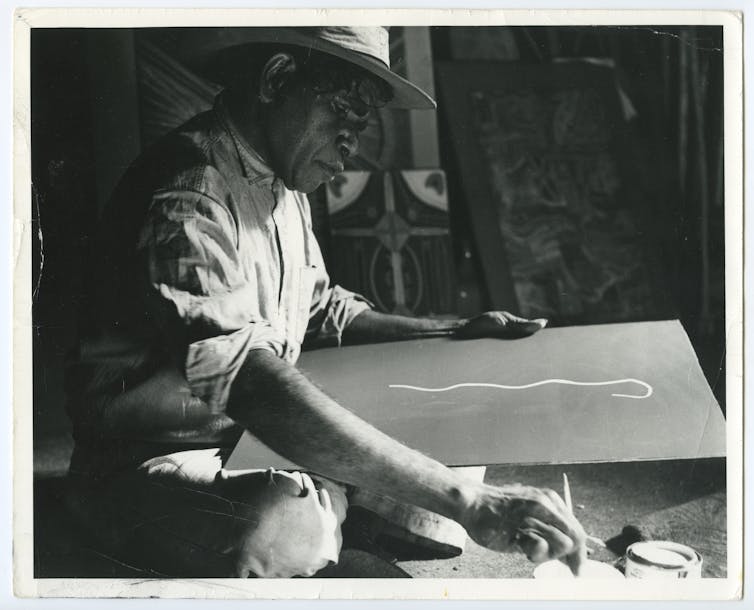
The posture of the artist in relation to the board or canvas they are painting has a powerful effect on the form and orientation of the resulting work. It is worth considering the way in which these early boards were produced, for such exigencies affect how they are read.
Typically, desert art takes a planar perspective, in which sites and protagonists are depicted as “signs” in space. The early boards were small enough to be painted on the artist’s knees, where they were revolved to allow the whole picture plane to be reached. This method often resulted in compositions in which the painting’s energy was centralised, such as John Tjakamarra’s Ceremony (1972) and/or which expands concentrically from a living centre, such as Uta Uta Tjangala’s Bush Tucker (1971–72).
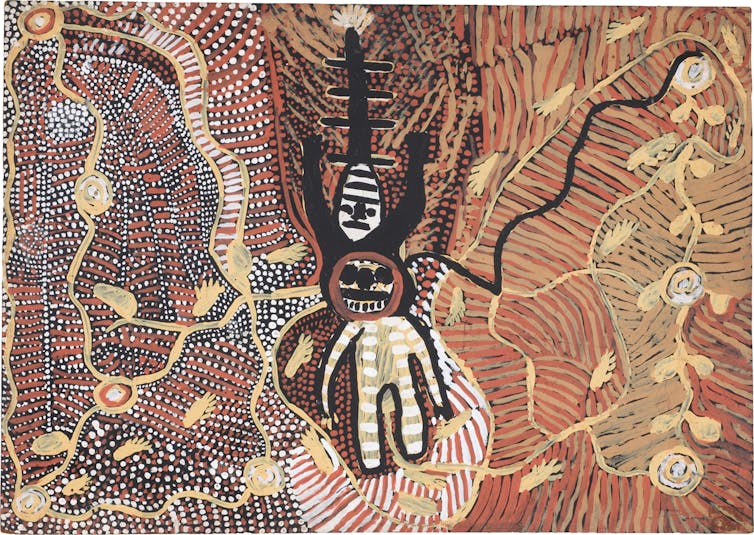
It is worth pausing to note that the composition of Papunya paintings changed considerably in the mid-1970s when larger canvases were introduced. In contrast to small boards that were painted on the lap, more recent canvases are painted flat on the earth, often in geographic relationship to the country represented.
Artists preferred to move around a sizeable canvas, reaching over to its centre, rather than to revolve the work, as is practical with smaller boards. Large canvases enabled space and topography to be modelled convincingly. Early Papunya boards appear more cerebral, evoking an internalised, imaginative realm.
A shift in the focus of Australian art
The founding of Papunya art is habitually written with Bardon portrayed at its core, and his role as catalyst and impresario seen as the defining encounter. This originary narrative is told with a gifted and sensitive outsider as its principal protagonist, but it gives insufficient weight to contributions made by other key actors.
As a revisionist, I have sketched an alternate chronicle in which Kaapa is tracked and given emphasis. But neither version encompasses the dynamic heterogeneity of the original movement - which effectively shifted the focus of Australian art from the urban centres of the east coast to the arid heart of the continent.
Intended as a “half-way house” between “nomadism” and “civilised settlement” Papunya proved to be a providential meeting place for Indigenous ideas and culture. Despite occasional internecine conflict, men from distant lands discovered they were bound by their association with songlines and shared ceremony. In large part, it was the collision of remarkable individuals from disparate lands that sparked the creative energy from which Papunya Tula art has grown.
This is an edited version of an article in the book Tjunguṉutja: from having come together, edited by Luke Scholes.
The exhibition Tjunguṉutja: from having come together featuring this collection of early Papunya paintings and documenting the rise of Western Desert art will show at the Museum and Art Gallery of Northern Territory from July 1 until February 18, 2018.![]()
John Kean, Writer and curator, Indigenous art and natural history illustration, The University of Melbourne
This article is republished from The Conversation under a Creative Commons license. Read the original article.







